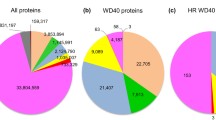Abstract
Proteins with Ankyrin repeat motifs (ANK) are found to be associated with diverse biological processes and molecular functions in most of the studied organisms. Several studies have been done on the ANK-motif containing proteins of various model species, but similar studies on their counterparts in brown algae are not available. In this study, we have identified a total of 1,372 ankyrin repeats in 339 proteins of the model brown algae Ectocarpus siliculosus and the consensus sequence of the ANK repeats was determined. The proteins were classified into eight different subfamilies depending on their structural diversity. The data provided in this study may provide useful basis for future reverse genetics analysis of the members of this family.
Similar content being viewed by others

References
Bailey, T.L., Williams, N., Misleh, C., Li, W.W. 2006. MEME: Discovering and analyzing DNA and protein sequence motifs. Nucl Acid Res 34, 369–373.
Becerra, C., Jahrmann, T., Puigdomenech, P., Vicient, C.M. 2004. Ankyrin repeat-containing proteins in Arabidopsis: Characterization of a novel and abundant group of genes coding ankyrin-transmembrane proteins. Gene 340, 111–121.
Breeden, L., Nasmyth, K. 1987. Similarity between cell-cycle genes of budding yeast and fission yeast and the Notch gene of Drosophila. Nature 329, 651–654.
Cock, J.M., Sterck, L., Rouzé, P., Scornet, D. et al. 2010. The Ectocarpus genome and the independent evolution of multicellularity in brown algae. Nature 465, 617–621.
Crooks, G.E., Hon, G., Chandonia, J.M., Brenner, S.E. 2004. WebLogo: A sequence logo generator. Genome Res 14, 1188–1190.
Huang, J., Zhao, X., Yu, H., Ouyang, Y., Wang, L., Zhang, Q. 2009. The ankyrin repeat gene family in rice: Genome-wide identification, classification and expression profiling. Plant Mol Biol 71, 207–226.
Jebanathirajah, J.A., Peri, S., Pandey, A. 2002. Toll and interleukin-1 receptor (TIR) domain-containing proteins in plants: A genomic perspective. Trends Plant Sci 7, 388–391.
Larkin, M., Blackshields, G., Brown, N., Chenna, R., McGettigan, P., McWilliam, H., Valentin, F., Wallace, I., Wilm, A., Lopez, R. 2007. Clustal W and Clustal X version 2.0. Bioinformatics 23, 2947–2948.
Li, J., Mahajan, A., Tsai, M.D. 2006. Ankyrin repeat: A unique motif mediating protein-protein interactions. Biochemistry 45, 15168–15178.
Mahmood, N., Moosa, M.M., Matin, S.A., Khan, H. 2012. Members of Ectocarpus siliculosus f-box family are subjected to differential selective forces. Interdiscip Bio Central 4, 1–7.
Marcotte, E.M., Pellegrini, M., Yeates, T.O., Eisenberg, D. 1999. A census of protein repeats. J Mol Biol 293, 151–160.
Mosavi, L.K., Cammett, T.J., Desrosiers, D.C., Peng, Z.Y. 2004. The ankyrin repeat as molecular architecture for protein recognition. Protein Sci 13, 1435–1448.
Mosavi, L.K., Minor, D.L., Peng, Z.Y. 2002. Consensus-derived structural determinants of the ankyrin repeat motif. Proc Natl Acad Sci 99, 16029–16034.
Saitou, N., Nei, M. 1987. The neighbor-joining method: A new method for reconstructing phylogenetic trees. Mol Biol Evol 4, 406–425.
Sedgwick, S.G., Smerdon, S.J. 1999. The ankyrin repeat: A diversity of interactions on a common structural framework. Trends Biochem Sci 24, 311–316.
Seong, E.S., Choi, D., Cho, H.S., Lim, C.K., Cho, H.J., Wang, M.H. 2007. Characterization of a stressresponsive ankyrin repeat-containing zinc finger protein of Capsicum annuum (CaKR1). J Biochem Mol Biol 40, 952–958.
Tamura, K., Dudley, J., Nei, M., Kumar, S. 2007. MEGA4: Molecular evolutionary genetics analysis (MEGA) software version 4.0. Mol Biol Evol 24, 1596–1599.
Wang, Y.S., Pi, L.Y., Chen, X., Chakrabarty, P.K., Jiang, J., De Leon, A.L., Liu, G.Z., Li, L., Benny, U., Oard, J. 2006. Rice XA21 binding protein 3 is a ubiquitin ligase required for full Xa21-mediated disease resistance. The Plant Cell 18, 3635–3646.
Yan, J., Wang, J., Zhang, H. 2002. An ankyrin repeatcontaining protein plays a role in both disease resistance and antioxidation metabolism. Plant J 29, 193–202.
Zhang, H., Scheirer, D.C., Fowle, W.H., Goodman, H.M. 1992. Expression of antisense or sense RNA of an ankyrin repeat-containing gene blocks chloroplast differentiation in arabidopsis. The Plant Cell 4, 1575–1588.
Author information
Authors and Affiliations
Corresponding author
Rights and permissions
About this article
Cite this article
Mahmood, N., Moosa, M.M., Tamanna, N. et al. In silico analysis reveals the presence of a large number of Ankyrin repeat containing proteins in Ectocarpus siliculosus . Interdiscip Sci Comput Life Sci 4, 291–295 (2012). https://doi.org/10.1007/s12539-012-0134-9
Received:
Revised:
Accepted:
Published:
Issue Date:
DOI: https://doi.org/10.1007/s12539-012-0134-9



